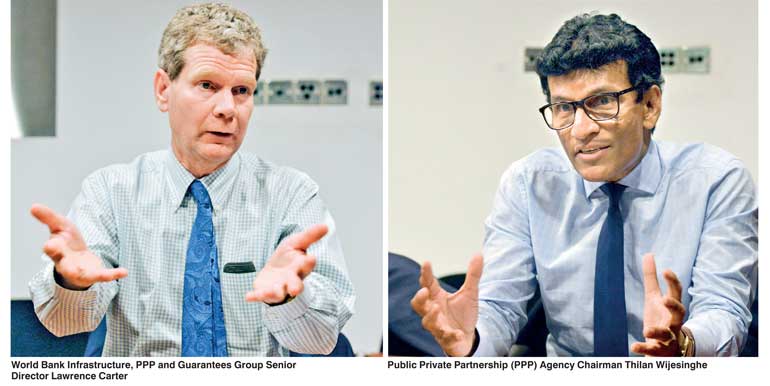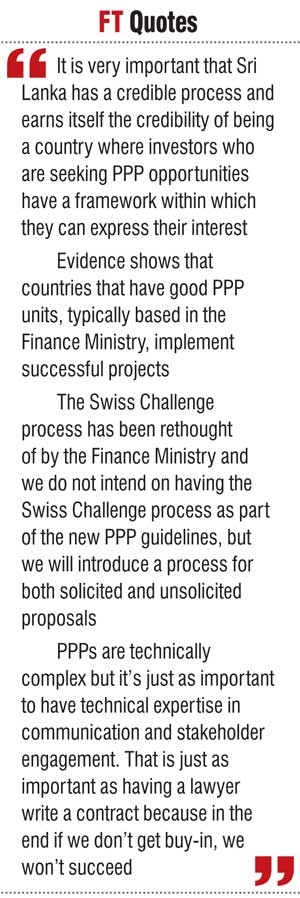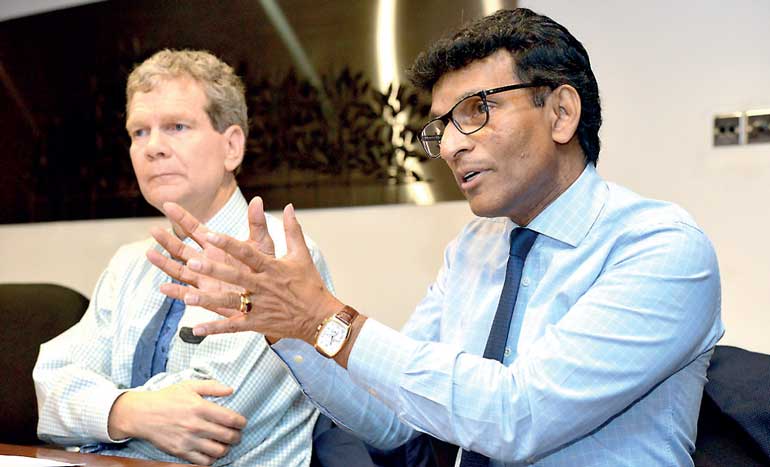Tuesday Dec 16, 2025
Tuesday Dec 16, 2025
Tuesday, 3 April 2018 00:00 - - {{hitsCtrl.values.hits}}

Public Private Partnerships (PPPs), when done right, have the capacity to deliver infrastructure and investment to important sectors to foster economic growth believe National Agency for PPPs Chairman Thilan Wijesinghe and World Bank Infrastructure, PPP and Guarantees Group Senior Director Lawrence Carter. Given below are excerpts of the interview:
By Uditha Jayasinghe
Q: Infrastructure globally has become a cross cutting agenda, especially for MDBs. How can infrastructure and infrastructure funding achieve more in a developing country?
LC: Our shareholder countries are very keen on infrastructure. Investment in infrastructure ties in well with economic growth and if it is done well more people get access to services, which is good for income distribution. Investment infrastructure is seen by governments and the MDB community as something we need more of. It is also widely recognised that if we are going to achieve Sustainable Development Goals (SDGs) we won’t be able to do it with Government resources alone. We have to crowd in the private sector, both for financial purposes and better management. Recognising this the World Bank is doing something called maximising finance for development, which means crowding in more resources, primarily from the private sector to achieve development in infrastructure. 
TW: PPPs are seen as a means to obtain private sector led financing for physical and social infrastructure. I think it’s important to emphasise that even social infrastructure can be provided via PPPs; whether it is digitisation, education, or healthcare. Why the National Agency for Public Private Partnership (PPP) is housed within the Finance Ministry is that it provides the Ministry with the option of looking at three separate buckets from which financing can be obtained. So the first would be though Treasury funding, the second would be external funding such as government to government funding, the third source is PPPs. This third bucket also includes viability gap funding, which is increasingly being made available by the World Bank and other donor agencies. This provides greater flexibility for a country to decide, which bucket they can throw a particular infrastructure projected into, looking at criteria such as the fiscal position, competitiveness, technology transfer, and management expertise.
Q: Transparency is a critical part of tendering. How can this be achieved in a developing country context?
LC: Ideally transparency starts even before you get to the tendering process. Countries like Australia make a list of infrastructure projects and the pipeline of projects is published so that investors and public see what is coming down the pipe. During the tendering process it is very good to have transparency around the issuance of the initial Expressions of Interest (EOI), request of proposals and given release bidders feedback. It’s not just about the contracting process. If it is a PPP then it’s about a long term arrangement and so we see best practice countries like Canada publishing the contract that is actually signed and then publishing information under performance of the contract. All of this builds trust between the public and the Government and holds the contracting party accountable.
TW: From a Sri Lankan perspective it is very important that Sri Lanka has a credible process and earns itself the credibility of being a country where investors who are seeking PPP opportunities have a framework within which they can express their interest. If you go back to the 1996-2000 era when I was the Board of Investment (BOI) Chairman, that was the time when Sri Lanka embarked on the PPP journey and financially closed almost a $1 billion worth of PPP projects over a five-year period. Virtually each of those was a first of its kind, whether it was ports, power or telecommunications.
During that time we had the 1998 guidelines for BOO/BOT type projects and during that period the BOI did not accept or negotiate a single unsolicited proposals; they were all transparently procured via an Expression of Interest or Request for Proposal process. Subsequently there were times when unsolicited proposals were the norm rather than the exception. But with the new guidelines we are proposing an update of the 1998 guidelines. We will be looking to create a credible process that will emphasise the transparency aspect by starting with a pre-feasibility study where the line Ministry would obviously initiate such projects and then issuing requests for proposals and going through that transparent negotiating process with the emphasis on value for money.
Fundamentally a PPP is a negotiation. That doesn’t mean the window will be shut for unsolicited proposals, there will always be discretion at the level of Cabinet or go Government vernment to seek unique types of projects that have significant value for money; but the idea is that even such projects would still go through the negotiation process of obtaining maximum value for money. These guidelines will be published shortly. They are already 95% complete and we are hopeful this will create a credible environment for both local and foreign investors.
Q: Do the guidelines also include the best practices of releasing contract details and other information?
TW: Yes. There are five phases under the new guidelines. The final phase would be the line ministry would have specific criteria that they would have to adhere to ensure contractual obligations entered into by the Government and the PPP investor would be followed. There is also a planning phase prior to solicitation and there would be post signing contract execution monitoring.
Q: Would these contracts be presented before Parliament or other public access forums?
TW: The request for proposals would be uploaded to a website of the Line Ministry and NAPPP and widely distributed, and the concessions agreements would be approved by the Cabinet. I see no reason why the entire process cannot be open to public scrutiny and most PPP projects would also have to go through an environment impact assessment. There are many aspects of a PPP that would lend itself to being scrutinised by the public from the perspective of their economic justification to environment and social issues and finally ensuring contractual agreements entered into are well balanced where the risk elements are shared in an equitable manner between the Government and the private sector investor.
Q: The Government does receive unsolicited proposals. What is the best way for the Government to deal with them and still ensure transparency and project success?
TW: To establish a PPP unit. A credible agency for PPPs, which becomes a single facilitation point for the line ministry and the private sector so that both the line ministries and the Finance Ministry build capacity to identify projects and evaluate, which bucket they should fall into and then channel them through the line ministry and the PPP unit to go before the public. Once we establish these guidelines and a project pipeline, an environment of discipline will be established both within the Government and the private sector in understanding that Sri Lanka is open for business, but not sweetheart deals. The idea is to proceed as much as possible on solicited proposals.
LC: Evidence shows that countries that have good PPP units, typically based in the Finance Ministry, so they can look at the trade-offs of projects and are close to fiscal resources needed to support PPPs, implement successful projects. We are delighted with the leadership being shown in Sri Lanka and the World Bank is already supporting that and we are very hopeful this will be a very successful PPP programme.
Q: Would you encourage the Government to put most projects through the PPP process? We have seen a propensity for the PPP agency to be bypassed. How will the PPP agency be the centre of this process?
TW: Unsolicited proposals have not been as pervasive in the last two years as one might imagine. Having said that there have been certain government-to-government initiatives, which is the prerogative of the participating governments and the idea is that they would be subjected to the negotiating process. For example in the case of the South Asia Gateway Terminal (SAGT) project, because of the conflict, though 14 parties picked up the RFP document, there was only one valid bid. However, that bid went through an extensive negotiating process, which included the Government extracting significantly more value that what was put on the table initially.
The issue is not to be focused on whether a proposal is solicited or unsolicited, but that it goes through this rigorous negotiating process so it is a defensible, value for money transaction that would generate the sort of synergist value for both the developer and country. Of the concession agreements the Government has entered into since 1996 there have been no failures, though some have been renegotiated. Even the Port City project was stopped, renegotiated and restarted.

Q: The Government has adopted the ‘Swiss Challenge’ process to deal with unsolicited proposals. What are your views? Is ‘Swiss Challenge’ a worthwhile structure to employ? If so how should it be adapted?
LC: We generally don’t find the ‘Swiss Challenge’ system leads to genuine competitive process because other bidders are not willing to participate. They know the original proponent can match their price. We think it is not an optimal approach to use.
TW: The ‘Swiss Challenge’ process has been rethought of by the Finance Ministry and we do not intend on having the ‘Swiss Challenge’ process as part of the new PPP guidelines, but we will introduce a process for both solicited and unsolicited proposals. Certainly the ‘Swiss Challenge’ process will be discouraged.
Q: Sri Lanka’s Government has a long list of potential PPP projects but tendering and negotiation has always been a challenge. How can this be tackled more effectively?
TW: There are already some projects in the pipeline that are at an advanced stage so the challenge is how fast we can actually close such transactions. Through the guidelines we are attempting to identify the typical areas where process can get potentially delayed, which would be in areas such as environmental assessment. So the guidelines will specify certain aspects of a PPP that can be done in parallel rather than doing things sequentially. If you define well what you want at the outset, you can bring in the CEA and Attorney General’s Department in advance to the process, as this would save time in complex PPP transactions.
The guidelines would look at how the negotiating and project committees could be coordinated to establish a faster process and at what point Cabinet approval would be needed. However, by definition PPPs are complex, that is why the PPP agency has to be sent up with the sort of skill sets, such as financial and legal structuring, that are complementary to the relevant line ministries and agencies. Bringing in people with the right skills is also critical in taking a process forward very quickly. If you look at examples where bottlenecks have been created it is typically because on the Government side the right skills were not brought in, whether in the public service or externally, to participate in the process.
Q: You mentioned that several projects were at an advanced stage. Are you at liberty to say what they are?
TW: The inland water transport project, using the prevailing Dutch canals, there are a few power projects and an elevated highway project from Rajagiriya to the new Kelani Bridge, which has gone through an EOI process. These projects are following the 1998 guidelines or the 2006 procurement guidelines. We are trying to unify prospective projects under the 1998 guidelines.
Q: How can risk be better divided between the Government and private investor?
LC: Risk needs to be allocated to the party that is best able to bear it. There are certain categories of risk where that is typically the Government, for example land acquisition is something better undertaken by the governments and the private sector can handle construction risk. Most important thing is to have a rigorous preparation process and ensure the Government has access to top quality technical and legal advisors who can structure the project and undertake market soundings, meeting with parties that have passed the EOI process and get feedback on the potential structuring so that when something goes out to the market it is bankable. This enables the private sector to have a chance to give some information beforehand. Also, it’s important to have consultations with larger stakeholders because at the end of the day it’s not just about a contract but society should feel the process is fair. In the end it is a social contract that includes the people.
Q: What would your top three recommendations or lessons be to a developing country keen to make PPPs successful?
LC: Have a strong, central PPP unit, with political leadership above, which is authorising the central unit. The central unit needs to make sure that all the Central Government departments are coordinated. That is number one. In about 50% of failed cases either the political will fades away or the central unit isn’t strong enough to coordinate Government. Second, take control of the process, meaning take control of the tendering process, identifying projects and how they link to larger goals, then running the process. Government should not be on the back foot, responding to unsolicited proposals, they should drive the process with as much transparency as possible. Third; get stakeholder buy-in, mitigate concerns and deal with issues by engaging with people consistently.
Q: Financing is what usually drives a project, sometimes with less desirable results. How can attention be shifted away from financing to ensure quality?
LC: Countries that get PPPs right are not motivated by financing. Government use screening tools to decide when to bring in the private sector and then run a process where it is up to the winning bidder to identify the sources of financing. Governments that are controlling the process are not driven by financing; they are driven by value for money, efficiency and improving access to services.
Q: Land acquisition and land rights are extremely important. How can the Government work to encourage projects while protecting land rights?
TW: As the State owns the major portion of land we should ideally allow the chief valuer to guide the process as happens now. But where the PPP agency would come into the process is to advice the line ministry and provide the right policy guidelines on certain projects, get the Finance Ministry involved in funding aspects of the PPP project that are not viable for private sector investment like access roads and other common infrastructure. That’s where the Government would step into provide these needs and offer the land on a transparent basis that would eventually result in the identified gap being filled by the private sector within the parameters identified by the Government at the outset. Certainly the State needs to maximise land value but in some instances where the private sector has not delivered on certain types of social infrastructure we need to look at how these land are released in a concessional manner for private investment in a transparent way, working on with the UDA and Megapolis Ministry.
Q: Local participation in PPPs is important. How can this be encouraged? What incentives could be offered to attract local private sector investment?
LC: The political economy of PPPs is such that it’s actually very good protection for a PPP programme to have significant local participation. Relatively smaller PPPs that local banking system and investors can bear would be a good place to start. Large PPPs tend to be very political, complex and time consuming but smaller PPPs is a good way to move things through the system and have people become familiar with the process. Street lighting or aspects of the healthcare are examples of such PPPs. Governments can signal to companies and request local participation. The messaging has to be careful but it is within the purview of Government to seek consultation, which then leads shrewd international companies to seek local partners to set up consortiums.
Q: Given your experience in the transaction advisory department, what would your golden rules be for managing transactions for large-scale PPP and infrastructure projects?
LC: I would be wary of larger scale PPPs, I would try to start off with small scale PPPs. Secondly all PPPs need political leadership so the President, or Prime Minister or Finance Ministry needs to be supportive and there needs to be a Government coordinating committee, so the Attorney General is on board, land issues are resolved and environment is protected. A strong PPP unit in the centre, both to coordinate Government, but also to interface with the private bidders. One of the biggest uncertainties for private bidders is how and when decisions are made and the more clarity that can be provided about the process the more reassured bidders will be and the better it will be for the Government. PPPs are technically complex but it’s just as important to have technical expertise in communication and stakeholder engagement. That is just as important as having a lawyer write a contract because in the end if we don’t get buy-in, we won’t succeed.
– Pix by Daminda
Harsha Perera